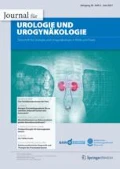Zusammenfassung
Ein fieberhafter Harnwegsinfekt kann zu einer Urosepsis führen und daher ist eine rasche Diagnostik und Behandlung notwendig. Besonders wichtig sind eine ausführliche Anamnese und Diagnostik, bei der initialen Bildgebung reicht in der Regel eine Sonographie. Diese kann sehr zuverlässig eine Harntransportstörung (Harnstau, Blasenentleerungsstörung) diagnostizieren. Weitere bildgebende diagnostische Maßnahmen sind hilfreich, um die Diagnose weiter zu sichern. Vor Einleitung einer antibiotischen Therapie ist eine korrekte Uringewinnung für eine Urinkultur enorm wichtig. Nach der Abnahme von Urin sollte sofort mit einer Antibiose begonnen werden, deren Auswahl hängt vom Keimspektrum ab, aber eine Breitbandantibiose, z. B. Zephalosporine der 3. Generation und Aminoglykoside oder Piperacillin/Tazobactam, ist gut geeignet. Eine einfache Regel ist: „Hit early and hit hard!“ Es gibt mehrere Optionen für die chirurgische Intervention und Entlastung des Harntrakts bei Obstruktion. Diese sollten je nach initialer Pathologie und dem Allgemeinzustand des Kindes eingesetzt werden. Durch die zeitnahe Diagnostik, Therapie und v. a. multidisziplinäre Zusammenarbeit können akute bzw. chronische Nierenschäden verhindert werden.
Abstract
Febrile urinary tract infection can lead to urosepsis and hence a rapid diagnosis and treatment is necessary. Particularly important are a detailed history and the diagnostic workup, whereby ultrasonography is usually sufficient as the initial imaging modality. It can very reliably diagnose urinary transport disorders (urinary retention, impaired bladder emptying). Further diagnostic imaging is helpful to confirm the diagnosis. Before initiating antibiotic treatment, it is important to collect a urine sample in the correct manner for a urine culture. Antibiotics should be started immediately after obtaining the urine sample; the selection of which depends on the bacterial spectrum, but a broad-spectrum antibiotic, e.g., third generation cephalosporins and aminoglycosides or piperacillin/tazobactam, is well suited. A simple rule is: “Hit early and hit hard!” There are several options for surgical intervention to relieve the urinary tract obstruction. These should be used depending on the initial pathology and the general condition of the child. Timely diagnosis, treatment, and especially interdisciplinary cooperation can prevent acute or chronic kidney damage.

Literatur
Oswald J (2017) Urosepsis in Children. Aktuelle Urol 48(5):459–468
Schmidt B, Copp HL (2015) Work-up of pediatric urinary tract infection. Urol Clin North Am 42(4):519–526
Hoberman A, Chao HP, Keller DM, Hickey R, Davis HW, Ellis D (1993) Prevalence of urinary tract infection in febrile infants. J Pediatr 123(1):17–23
Braga LH, Farrokhyar F, D’Cruz J, Pemberton J, Lorenzo AJ (2015) Risk factors for febrile urinary tract infection in children with prenatal hydronephrosis: a prospective study. J Urol 193(5 Suppl):1766–1771
Craig JC, Knight JF, Sureshkumar P, Mantz E, Roy LP (1996) Effect of circumcision on incidence of urinary tract infection in preschool boys. J Pediatr 128(1):23–27
Hufnagel M, Burger A, Bartelt S, Henneke P, Berner R (2008) Secular trends in pediatric bloodstream infections over a 20–year period at a tertiary care hospital in Germany. Eur J Pediatr 167(10):1149–1159
Round J, Fitzgerald AC, Hulme C, Lakhanpaul M, Tullus K (2012) Urinary tract infections in children and the risk of ESRF. Acta Paediatr 101(3):278–282
Beetz R (2012) Evaluation and management of urinary tract infections in the neonate. Curr Opin Pediatr 24(2):205–211
Klein Klouwenberg PM, Ong DS, Bonten MJ, Cremer OL (2012) Classification of sepsis, severe sepsis and septic shock: the impact of minor variations in data capture and definition of SIRS criteria. Intensive Care Med 38(5):811–819
Lellig E, Apfelbeck M, Straub J, Karl A, Tritschler S, Stief CG et al (2017) Urinary tract infections in children. Urologe A 56(2):247–262
Al-Orifi F, McGillivray D, Tange S, Kramer MS (2000) Urine culture from bag specimens in young children: are the risks too high? J Pediatr 137(2):221–226
Yamasaki Y, Uemura O, Nagai T, Yamakawa S, Hibi Y, Yamamoto M et al (2017) Pitfalls of diagnosing urinary tract infection in infants and young children. Pediatr Int 59(7):786–792
Tosif S, Baker A, Oakley E, Donath S, Babl FE (2012) Contamination rates of different urine collection methods for the diagnosis of urinary tract infections in young children: an observational cohort study. J Paediatr Child Health 48(8):659–664
Whiting P, Westwood M, Bojke L, Palmer S, Richardson G, Cooper J et al (2006) Clinical effectiveness and cost-effectiveness of tests for the diagnosis and investigation of urinary tract infection in children: a systematic review and economic model. Health Technol Assess 10(36):iii–iv, xi–xiii, 1–154
Stein R, Dogan HS, Hoebeke P, Kocvara R, Nijman RJ, Radmayr C et al (2015) Urinary tract infections in children: EAU/ESPU guidelines. Eur Urol 67(3):546–558
Edlin RS, Shapiro DJ, Hersh AL, Copp HL (2013) Antibiotic resistance patterns of outpatient pediatric urinary tract infections. J Urol 190(1):222–227
Mantadakis E, Plessa E, Vouloumanou EK, Karageorgopoulos DE, Chatzimichael A, Falagas ME (2009) Serum procalcitonin for prediction of renal parenchymal involvement in children with urinary tract infections: a meta-analysis of prospective clinical studies. J Pediatr 155(6):875–81e1
Lutter SA, Currie ML, Mitz LB, Greenbaum LA (2005) Antibiotic resistance patterns in children hospitalized for urinary tract infections. Arch Pediatr Adolesc Med 159(10):924–928
Gaspari RJ, Dickson E, Karlowsky J, Doern G (2005) Antibiotic resistance trends in paediatric uropathogens. Int J Antimicrob Agents 26(4):267–271
Fernandez-Menendez JM, Malaga S, Matesanz JL, Solis G, Alonso S, Perez-Mendez C (2003) Risk factors in the development of early technetium-99m dimercaptosuccinic acid renal scintigraphy lesions during first urinary tract infection in children. Acta Paediatr 92(1):21–26
Beetz R (2018) Congenital dilatation of the upper urinary tract : current diagnostic and treatment concepts. Urologe A 57(8):969–986
Hwang JY, Shin JH, Lee YJ, Yoon HM, Cho YA, Kim KS (2018) Percutaneous nephrostomy placement in infants and young children. Diagn Interv Imaging 99(3):157–162
Author information
Authors and Affiliations
Corresponding author
Ethics declarations
Interessenkonflikt
A. Pandey, K. Bodenschatz, C. Hüttenbrink und S. Pahernik geben an, dass kein Interessenkonflikt besteht.
Dieser Beitrag beinhaltet keine von den Autoren durchgeführten Studien an Menschen oder Tieren.
Rights and permissions
About this article
Cite this article
Pandey, A., Bodenschatz, K., Hüttenbrink, C. et al. Fieberhafter Harnwegsinfekt mit Harntraktdilatation. J. Urol. Urogynäkol. 25, 174–178 (2018). https://doi.org/10.1007/s41972-018-0054-y
Published:
Issue Date:
DOI: https://doi.org/10.1007/s41972-018-0054-y

